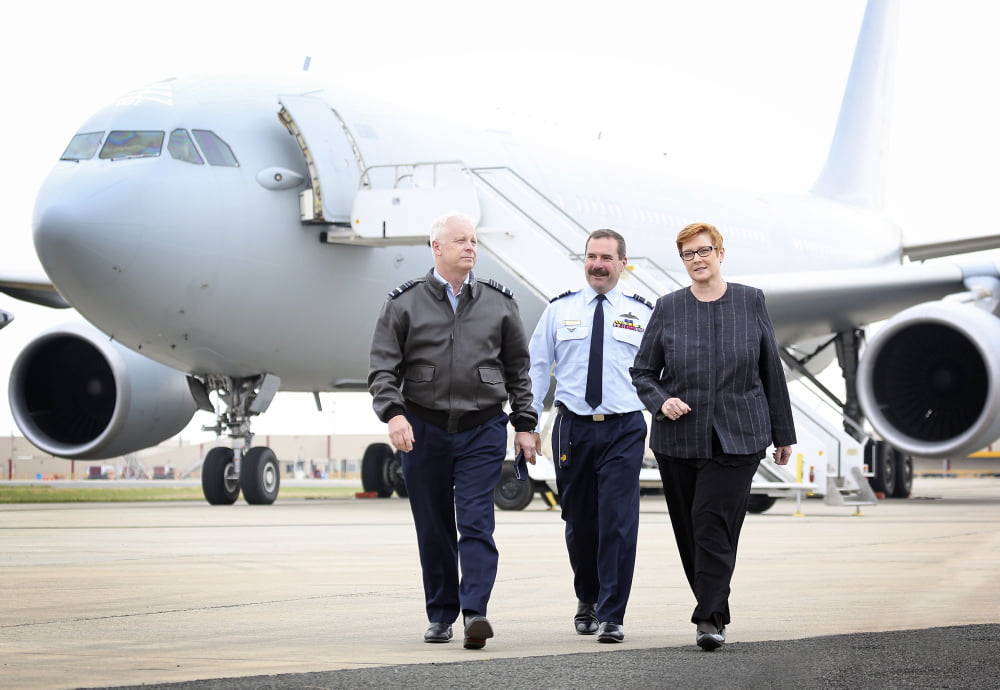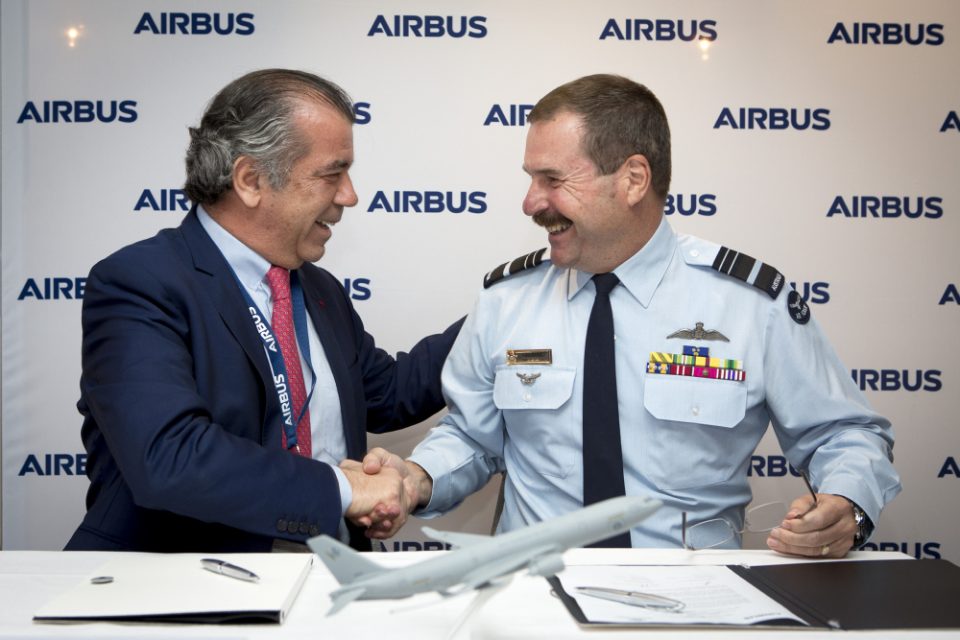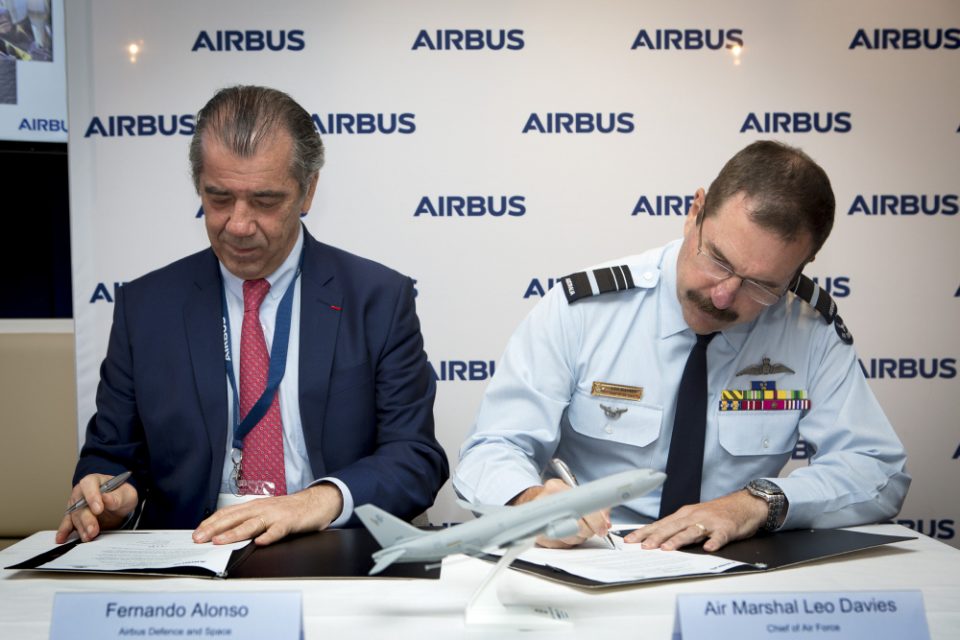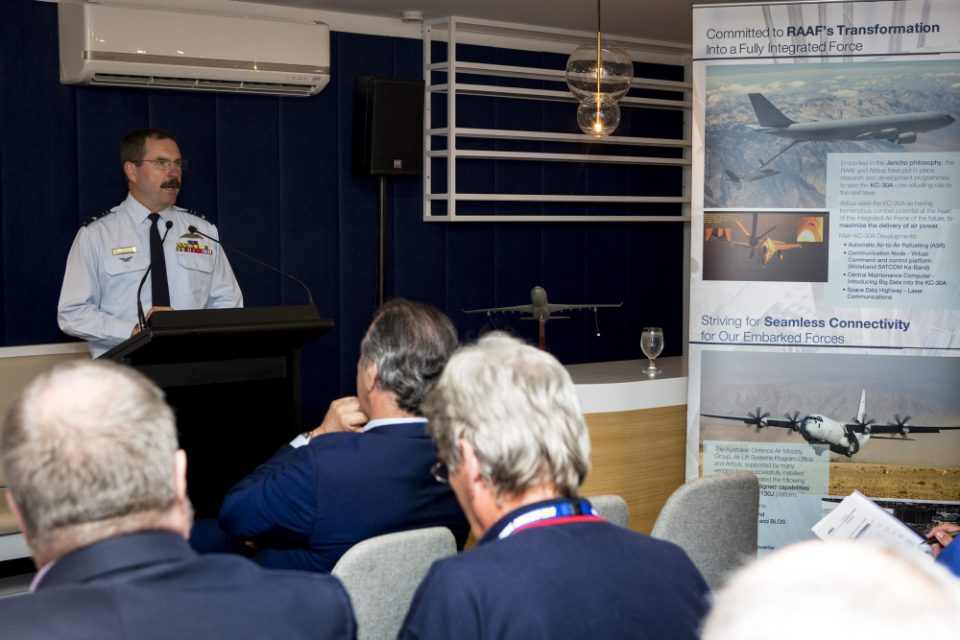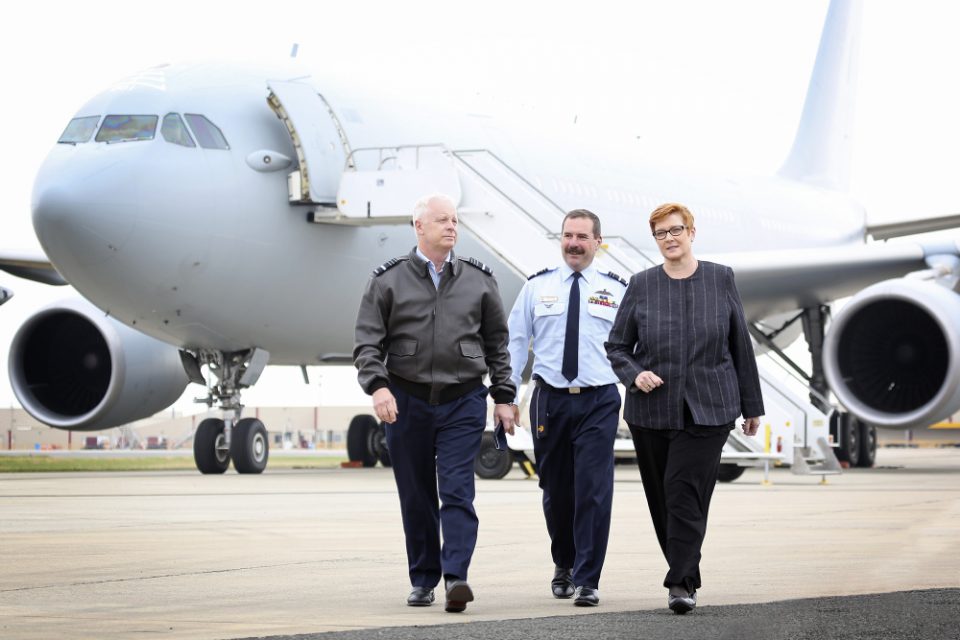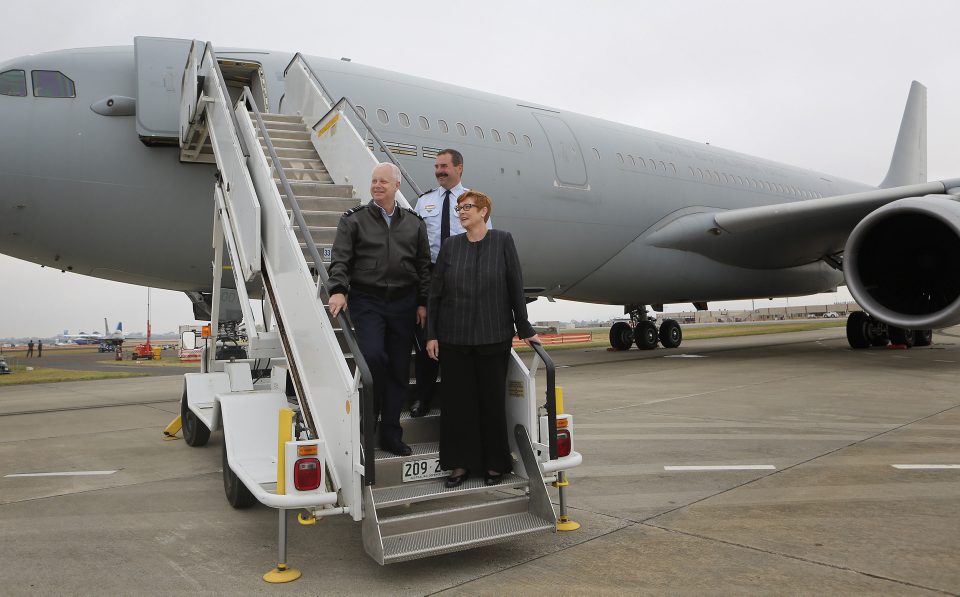2017-03-18 The Australian KC-30A was joined with the RAF’s A400M during its global reach into the Pacific during the Avalon Air Show in Australia.
The Aussie tanker represents the most mature advanced tanker in the world, while the A400M flown by the RAF has become a solid member of the Brize-Norton lift and tanking support structure to the RAF in its operations.
The two together are becoming key partners in a number of the world’s air forces.
The KC-30A Achieves Final Operational Capability
At the recent Australian Avalon Air Show, the RAAF declared their KC-30A to have achieved final operational capability (FOC).
As reported by Australian Aviation in an article published on March 2, 2017: “It is quickly becoming the tanker of choice,” Air Marshal Davies said of the KC-30A.
“We are now there where the aircraft has done so many receiver clearances that, having spoken to the Minister for Defence over the last couple of days, I would like to take this opportunity to declare final operational capability for the KC-30A MRTT in the Royal Australian Air Force,” AIRMSHL Davies told a media briefing.
“There has been a lot of hard work that has gone into its development, but … there is a lot more that this aircraft can do. Now that we have FOC we are able to go into that next smart phase [of developing the aircraft],” the Chief observed.
“This tanker has come a long way since its introduction, undertaking significant operational, test and evaluation activities with a range of coalition aircraft, including United States Air Force F-35A Lightning II aircraft. This was a vital test of the KC-30A, to ensure we are prepared for our future force, including our F-35A arriving in late 2018.”
Defence Minister Senator Marise Payne also noted the significance of the KC-30A achieving final operating capability in a statement….
“This is a significant milestone for the fleet, which is now able to refuel a range of aircraft from our Air Force and our international partners,” Minister Payne said.
“The KC-30A has been an outstanding asset over Iraq on Operation Okra, having offloaded over 74 million pounds of fuel to coalition aircraft, including Australia’s F/A-18A Hornet and E-7A Wedgetail aircraft. It is on the frontline, making sure the Hornets can take the fight to Daesh effectively.
“Just one KC-30A can support the deployment of four fighter aircraft over 5,000km, with 50 personnel and 12 tonnes of equipment. It is an extremely versatile aircraft that is suited to the long ranges of the Australian continent.”
http://australianaviation.com.au/2017/03/raafs-kc-30a-tanker-transport-achieves-foc/
The KC-30A and Airbus Defence Partner for the Next Phase of Tanker Development
And the Aussies have also signed an agreement with Airbus Defence and Space to partner in shaping what one might call Tanker 2.0, or the smart tanker. The tanker is a mature military product operated globally and now Australia is laying the foundation for the next transition, to shape new innovations through automation and linkages to shape the smart tanker.
According to a press release by Airbus Defence and Space:
Melbourne, 2 March 2016: The Royal Australian Air Force (RAAF) and Airbus today signed a research agreement to further develop the RAAF KC-30A’s capabilities.
The agreement strengthens the industrial partnership between Airbus and Australia’s defence force, and will help to define the evolution of the KC-30A fleet as it reaches operational maturity and expand its capabilities.
This will result in the KC-30A’s core transport and refuelling capabilities supporting the RAAF’s transformation into a fully integrated force, capable of tackling complex contemporary defence and security challenges.
The agreement’s first milestone is the joint development of the automatic air-to-air refuelling (A3R) concept, which represents a major step forward in in-flight refuelling.
Automating boom refuelling contacts reduces potential risk by minimising operator workload, and increases operational efficiency by cutting the time for each contact.The system requires no additional equipment in the receiver aircraft.
Initial approach and tracking of the receiver is performed manually from the A330 MRTT’s console. Once the image processing system acquires the receiver and the receptacle position, the operator can use the system aid allowing the boom to automatically follow the receptacle. Final extension of the boom’s telescopic beam is manually performed by its operator to make and maintain contact.
Fernando Alonso, Head of Military Aircraft at Airbus Defence and Space said: “The KC-30A offers tremendous combat potential at the heart of the integrated Air Force of the Future, including using the platform as a Communication Node, to maximise air power delivery.”
Air Marshal Leo Davies, Chief of Air Force, RAAF, highlighted the value of ongoing defence and industry collaboration.
“We are delighted to contribute to the research and development of A3R with Airbus to automate the process for boom refuelling without the need for control by our on-board air refuelling operator”, said Air Marshal Davies.
The Royal Australian Air Force and Airbus have successfully performed proximity trials, with physical contacts planned for the near future.
The RAF and the A400M in the Pacific
Joining the KC-30A at the Avalon Air Show was an the RAF with their A400M which has been engaged in a long distance tour.
The route covered by the RAF is via Hickam in Hawaii, Wellington New Zealand, Ohakea New Zealand, Auckland New Zealand, Avalon Australia, Jakarta Indonesia and Subang Malaysia.
The A400M has matured to the point that the key baseline aircraft if fully functional and operational and ready for the next phase of its evolution.
And this core baseline aircraft is ready for global export.
According to an article by George Allison published in the Uk Defence Journal and published on March 2, 2017:
Speaking at the Avalon 2017 Air Show in Australia, Wing Commander Simon Boyle said:
“Entry into service of any new aircraft type is a challenge and for the A400M it was especially so.
I see a positive trajectory for the aircraft. We have momentum building, we are just now starting to understand how good this aircraft can be.”
Wing Commander Simon Boyle added:
“Indication is that the aircraft will perform very well in the tactical role and on unprepared runways. We’re starting to understand how good the aircraft could be in the tactical environment.”
The aircraft is based at Brize-Norton and the Brize-Norton website in an article published March 8, 2017 provided this perspective on the visit to the region:
The RAF A400M, based at RAF Brize Norton, in Oxfordshire, is the newest aircraft in the RAF’s fleet. It boasts cutting edge technology, combined with sheer brute strength to make it a formidable strategic and tactical air lift platform. Able to deploy globally, it specialises in carrying over-sized loads and can transport a load of 25 tonnes over a range of 2,000 nautical miles.
Wing Commander Simon Boyle, Officer Commanding No. LXX Squadron said, “It is a real privilege to bring A400M Atlas to New Zealand for the first time, and to be able to share in the RNZAF’s 80th Anniversary Celebrations. Furthermore, with important military cargo delivered to numerous locations en-route it has also been a valuable opportunity to demonstrate the global reach that Atlas offers UK defence as we continue to advance the aircraft’s capabilities.”
Whilst in Ohakea the A400M ‘Atlas’ played host to a meeting between the Chief of the Royal New Zealand Air Force and the Chief of the Royal Air Force. After which gifts were exchanged and both thanked the crew and engineers for bringing the A400M ‘Atlas’ to Ohakea to celebrate a great partnership between the two nations.
Chief of the Air Staff, Air Chief Marshall Sir Stephen Hillier said:
“As Chief of the Air Staff I am delighted the Royal Air Force has been able to come to New Zealand to help celebrate the 80th anniversary of the Royal New Zealand Air Force. We have a long and rich history together going back over decades, going back over operations, and everything we do today.”
“It’s a fantastic new capability for the Royal Air Force, showing our ability to deploy all the way from the UK to the other side of the world really underlines the Air Forces Global Mobility capability in support of operations wherever they might be. We get here quickly and effectively in this fantastic new aircraft.
Air Vice-Marshal Tony Davies Chief of the Royal New Zealand Air Force said, “I did get to see the aircraft and have a good introduction with it last year. Wg Cdr Boyle kindly hosted me last July at LXX Squadron. I got to fly the simulator and go flying in the aircraft which was really impressive. Great range and payload. I am really envious that you’ve got them. This one has a lot of capability and a lot of credibility.”
“We have got a huge shared history together, our roots are from the RAF. It is very meaningful that on our 80th year the RAF is first and foremost the prime guests at our own party. To take the time and effort to come out here, especially for your CAS is really meaningful.”
The A400M ‘Atlas’ has clocked up 11500 miles since it left RAF Brize Norton less than 3 weeks ago, and headed to the Avalon Air Show in Australia after visiting Whenuapi.
There is a long-standing partnership between Australia and the UK, and the presence of the RAF A400M atlas from the UK is a clear demonstration of the commitment by the UK to the partnership.
Air Chief Marshall Sir Stephen Hillier, Chief of the Air Staff visited the aircraft to talk to the crew and engineers, he said, “Seeing the A400M ‘Atlas’ here in Australia. It demonstrates the quality of the RAFs Global reach and our Air Mobility capabilities…Our ability to fly this aircraft half way around the world is such an important demonstration of how important this aircraft is for the future of the RAF.”
“I would also like to offer my thanks and congratulations to Officer Commanding No. LXX Squadron, Wing commander Simon Boyle and all of the aircrew and engineers who are here in support of the A400M ‘Atlas’.
The aircraft has begun its journey back to the UK, picking up cargo on defence taskings along the way.
The photos in the first slideshow are credited to the Australian Ministry of Defense and the second to the Royal Air Force.
Editor’s Note: In an article published November 29, 2016, we focused on the emergence of Tanker 2.0.
The Airbus tanker is the only advanced tanker in operations and has been so for several years.
Airbus Defence and Space has sold tankers to a number of countries and has done so in what one might call national or serial sales.
Getting the tanker sold, and out in the operational space is shaping a baseline reality.
But with significant operational experience under their belt and with the focal point of Middle East operations, cross-cutting experiences are shaping the way ahead among the nations.
A baseline has been created from which what one might call Tanker 2.0 is emerging.
Tanker 2.0 can be understood in a couple of ways.
The first way is the coalescing of experience to shape a global fleet perspective whereby common experiences and con-ops shape the way ahead for the development of the tanker as well as providing an opportunity for global support.
The 330 Tanker program is not there yet, but with the experience of the nations under their belts and with the forcing function of operating in common in the Middle East, a baseline has been created which clearly can allow for this evolution.
In this phase of Tanker 2.0 the user groups can evolve in their importance.
There will soon be a user group meeting in Madrid. The evolution of the role of the user group was described by one Airbus Defence and Space official as moving in the early days from a brief BY the company to the users to the emergence of genuine interaction AMONG the users to dialogue with the company about the way ahead for tanker modernization and ways to shape a global fleet approach.
The second way would focus on how and paths to upgrade the tanker as a combat asset in the extended battlespace.
Because the plane carries the fuel for tanking in the wings, the internal space of the tanker, which currently is used for passengers or cargo, can be modified in various ways to be much wider combat support asset in the extended battlespace.
There is clearly thinking under way, notably in Australia, about how to take the tanker to this next step from being an MRTT in terms of combining lift and tanking functions to becoming a much wider combat support asset in terms of ISR, and C2 functions.
After my recent visit to the Albacete Air Base in Spain, I visited the Airbus Defence and Space facility in Madrid, namely the Getafe facility. I had a chance to discuss the baseline and the way ahead with the head of the tanker program, namely, Antonio Caramazana.
I first met Antonio Caramazana at an Airbus Defence and Space (then Airbus Military) Trade Media brief for the media in 2010. That briefing which he gave only six years ago shows how far the tanker has come in only six years.
https://sldinfo.com/an-update-on-the-a330-mrtt-2010/
We started by getting an update on the status of the tanker and discussing the baseline.
We then went on to discuss the evolution of the aircraft from a platform to a fleet, with the inherent opportunities to shape a global fleet solution.
Question: Certa 2016, what is the current status of sales and operational experience of your tanker?
Antonio Caramazana: We have delivered 28 tankers to date.
We have delivered 14 to the UK; 5 to Australia; 6 to Saudi Arabia and 3 to the UAE.
These aircraft already integrated into operations.
The fleet is operating and is demonstrating its value added.
And all are operating in the Middle East, which has provided a significant opportunity for the users to gain joint knowledge about the tanker and its capabilities.
They are even doing combined operations in a number of cases.
Question: You have sold the aircraft to several customers, but rather than just serial sales, you are seeing cross learning?
Antonio Caramazana: That is true.
For example, in the case of the clearance of receivers of fuel from the aircraft, the traditional approach would see a case by case national approach.
But there a particular national user is doing clearances, which provide certifications for other national users.
This is a culture shift for the air forces, which is provided by having a common aircraft, which is recognized as such by the air forces.
In effect, we are already seeing a global fleet which broaden the impact of the tanker.
For example, U.S. aircraft are being tanked by the various national tanker due to certification being done by specific nations which then allow the U.S. to tank into other national tankers.
Question: The next phase, which I will call Tanker 2.0, is to shape deliberately a global fleet. What are some of the key building blocks in your view to going down this path?
Antonio Caramazana: We are developing a A330 MRTT advanced which is designed to deliver a common aircraft, with common upgrade paths and solutions.
This will allow nations to get better value for money for their modernization investments.
Common configurations will be better for operations, and upgrades.
It will as well enhance common solutions to training, to parts supplies and to maintenance.
This is a way ahead for what you are calling Tanker 2.0.
This provides for culture change for both the militaries and industry to shape such a global solution.
The more users that buy into a common solution, costs can be contained with regard to upgrades, training and maintenance.
It will also allow tankers from one nation to fly to an area of interest and potentially leverage the support structure of a nation operating the tanker in that region of interest.
And the life cycle costs for such a global fleet will be lowered as well.
Our user groups are discussing paths to upgrades, more effective maintenance approaches, and other ways ahead to shape global solutions.
This is the advantage of already having several years of operations behind us as well as an aircraft with significant room for expansion of onboard systems as well.
Question: But Tanker 2.0 provides for another way ahead, namely to expand the contribution of the tanker to other combat assets in the battlespace.
How would you describe this way ahead?
Antonio Caramazana: From the inception of the A330MRTT, we have put into the market a very flexible asset with multiple capabilities.
You can combine passenger lift, cargo lift and tanking within the same platform, and countries like Australia or operating their C-17s with their tankers in very flexible ways in terms of cargo and passenger lift operating over both platforms while the tanking function allows both to go to the area of interest.
At the same time, with the evolution of militaries look to shape enhanced connectivity in the battlespace, a key way ahead is to rethink how the tanker can support other combat sets in terms of ISR and C2 functions.
This is work in progress, but given the flexibility of the tanker in terms of internal space, there are many possibilities for users.
This is about having a smart tanker able to link assets in the battlespace, air, ground or sea.
It can provide an ISR and C2 node function for the joint force in the battlespace. It is an information age aircraft as well as playing more classical role of a tanker.
See also the following overview:
An Update on the Airbus Tanker: The Aussie Experience
The Aussies are preparing for tanker 2.0 while the USAF awaits its first new tanker.
https://sldinfo.com/an-update-on-the-airbus-tanker-the-aussie-experience/
PDF Version
https://sldinfo.com/wp-content/uploads/2015/09/Update-on-Airbus-Tanker.pdf



